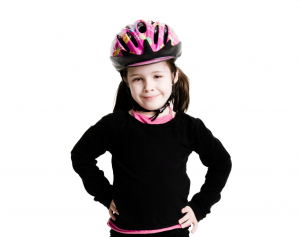National Bike to School Day & Global Road Safety Week
Sharing is caring!

At Safe Kids we know there are many great reasons to ride your bike – it offers fun, freedom, and exercise, and it’s good for the environment – and we encourage kids and families to ride as much as possible.
During National Bike Month, help us spread the word about bike safety by talking with your children and sharing the following simple tips to keep bike riding safe and fun.
- “Use your head, wear a helmet.” It is the most effective, simple and safe device available to reduce head injury and death from bicycle crashes.
- Tell your kids to ride on the right side of the road, with traffic, not against it. Stay as far to the right as possible. Use appropriate hand signals and respect traffic signals, stopping at all stop signs and stoplights.
- Teach your kids to make eye contact with drivers. Bikers should make sure drivers are paying attention and are going to stop before they cross the street.
- Be bright and use lights when riding at dusk, dawn or in the evening, and make sure your bike has reflectors as well. It’s also smart to wear clothes and accessories that have retro-reflective materials to improve biker visibility to motorists.
- Actively supervise children until you’re comfortable that they are responsible to ride on their own.
More children ages 5 to 14 are seen in emergency rooms for injuries related to biking than any other sport. Helmets can reduce the risk of severe brain injuries by 88 percent – yet only 45 percent of children 14 and under usually wear a bike helmet
Find the Right Helmet Fit
- Make sure your child has the right size helmet and wears it every time when riding, skating or scooting which meet the U.S. Consumer Product Safety Commission’s (CPSC) standards.
- Make sure the helmet fits and your child knows how to put it on correctly. A helmet should sit on top of the head in a level position, and should not rock forward, backward or side to side. The helmet straps must always be buckled, but not too tightly. Safe Kids recommends kids take the Helmet Fit Test that you can find in this link https://www.safekids.org/video/safety-seconds-bike-helmets. Alternatively, following we provide a summary of this important tip:
- EYES check: Position the helmet on your head. Look up, and you should see the bottom rim of the helmet. The rim should be one to two finger-widths above the eyebrows.
- EARS check: Make sure the straps of the helmet form a “V” under your ears when buckled. The strap should be snug but comfortable.
- MOUTH check: Open your mouth as wide as you can. Do you feel the helmet hug your head? If not, tighten those straps and make sure the buckle is flat against your skin.
Every day in the United States, nearly 60 kids under the age of 19 are hit by cars while walking.
Sometimes passing laws is not the most direct route to make a change. Grassroots action such as a community’s Action Against Distraction campaign can be substantial. For example, if traffic is routinely moving faster than a speed limit of 25 mph, ban together and hold concentrated, visible efforts to alert drivers of the speed limits. Similar tactics can make a powerful statement against distraction. Head Up, Phones Down is a simple, yet effective statement.
Distracted walking is on the rise. In a study involving over 39,000 observations, Safe Kids Worldwide observed distracted walking in 1 in 4 high school students and 1 in 6 middle school students. These distracted teens were most often texting or wearing headphones.
Stay Safe and Bike fun!
Join us on Facebook


